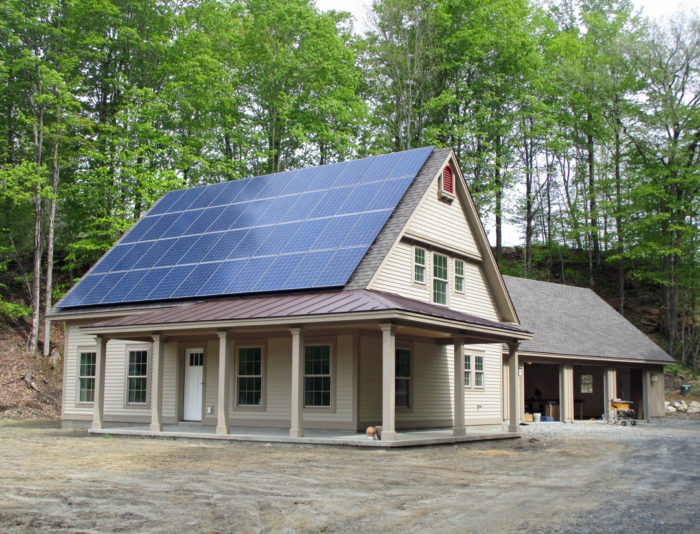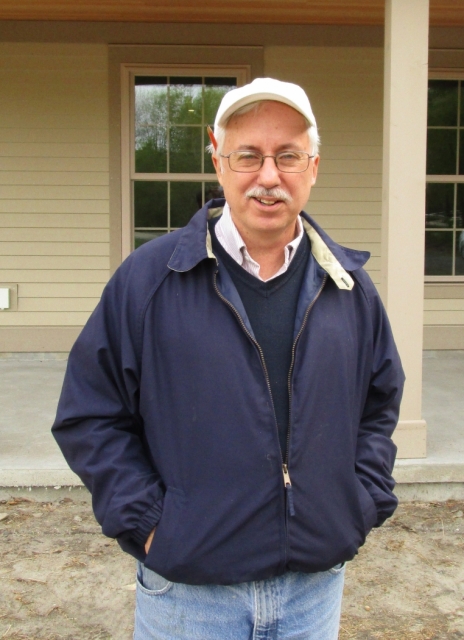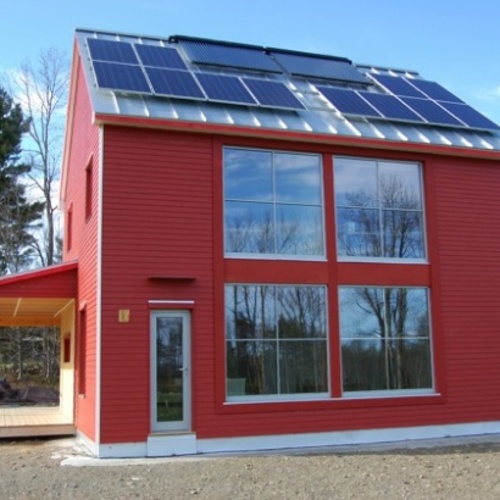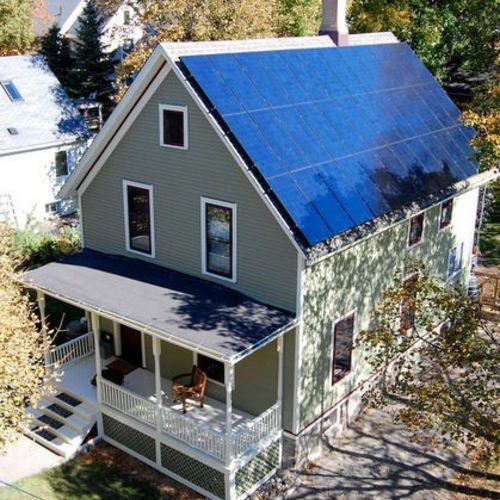
Image Credit: Image #1 and photos embedded in the article are by Martin Holladay
A few weeks ago, my wife and I went on a short hike with our college-age son. As the three of us drove to the trailhead in Norwich, Vermont, we passed a construction site. “Looks like a zero-energy house,” I observed. The sign out front read, “Prudent Living Homes.” I decided to get more information on the house and return later to try to talk with the builder.
I called up Prudent Living Homes, and the owner of the company, Paul Biebel, agreed to meet me at the site. When I showed up a few days later, two carpenters, Gary Castellini and Maynard White, were working on exterior details.
The house in Norwich is a custom three-bedroom home measuring 2,500 square feet. The home’s 13-kW photovoltaic (PV) array should produce enough electricity on an annual basis to more than meet the home’s electrical needs.
The foundation consists of perimeter stemwalls surrounding a slab on grade. (The design originally called for a basement; however, once the excavator started digging the foundation hole, a natural spring bubbled up — one that no amount of drainage pipe was likely to defeat. The team decided to switch gears and build on a slab.) Insulated concrete forms (ICFs) from Nudura were used for the stemwalls; additional rigid foam installed on the exterior side of the ICFs increased the R-value of the walls to R-22. A 4-inch-thick horizontal layer XPS (rated at R-20) was installed under the slab. (See Image #2 at the bottom of the page.)
The R-45 double-stud walls are 12 inches thick, and are insulated with dense-packed cellulose. (See Images #3 and #6 at the bottom of the page.) The roof is insulated to R-60.
Paul Biebel, owner of Prudent Living Homes in Windsor, Vermont, has been building homes since 1976. “I’ve…
Weekly Newsletter
Get building science and energy efficiency advice, plus special offers, in your inbox.

This article is only available to GBA Prime Members
Sign up for a free trial and get instant access to this article as well as GBA’s complete library of premium articles and construction details.
Start Free TrialAlready a member? Log in
















36 Comments
A few Qs & comments...
What is the exterior air-barrier/dense-pack containment on the sloped R60 roof?
The 180 degree turn right out of / into the ERV seems a bit excessive, presumably due to space limitations (?). The slip joints of the duct ells and other hard-duct seams don't appear to be sealed at all- were they planning to come back hit it with duct mastic?
That slooks like a tankless on-demand hot water heater hanging on the wall- is it? If yes, what's the power rating on that sucker? (Seems like it would take a pretty huge electric service to provide reasonable hot water performance with an electric tankless at VT-style incoming water temps!)
Response to Dana Dorsett
Dana,
Q. "What is the exterior air-barrier/dense-pack containment on the sloped R-60 roof?"
A. It's either plywood or OSB. In an e-mail on this topic, Paul wrote, "On this Cape style house, instead of using traditional rafters and a ridgepole to shape the second floor, we designed a one-piece truss that had a 20-inch deep chord on the slopes. This would allow us to install 18 inches of dense-packed cellulose, giving us approximately an R-60 on the sloping part of the roof, where rafters would have been. We used the other two inches of leftover space to construct an uninterrupted 2-inch-deep plywood air shaft. Where the rafters sat on the top of the exterior wall, we installed “wind blocking” flush with the outside of the 12-inch wall to close off the gap where you could see into the eaves. We did this in every truss bay. We used ½-inch plywood to make our wind blocks and fastened them securely to cleats and then air-sealed around them."
While Paul described the material as 1/2-inch plywood, the photos show OSB -- so I'm guessing that the answer is OSB.
Domestic hot water
Q. "That looks like a tankless on-demand hot water heater hanging on the wall -- is it?"
A. I don't think so. The domestic hot water will be supplied by a 50-gallon Rheem heat-pump water heater. When I visited the job site, the heat-pump water heater had not yet been installed.
Q. "That looks like a
Q. "That looks like a tankless on-demand hot water heater hanging on the wall -- is it?"
If your talking about the blue tank in the plumbing lines, thats a pressure tank for well water.
It's the well pump controller
I would guess Dana is referring to the grey box on the wall, which is a Pentair constant pressure controller for the well pump.
Edit: and it looks pretty nice. I'm suddenly experiencing pump controller envy.
Objects on the wall
And the rectangular gray box on the wall is a pump control box. The label reads "Pentair" -- a pump brand -- and the hand-written inscription reads "Valley Artesian Well," the company that installed the pump.
P.S. Tim C. and I must have been writing simultaneously -- he beat me to it.
.
The OSB air barrier in the roof...
That OSB/ply air barrier in the roof on the exterior side of the dense-pack means that it needs a Class-II vapor retarder on the interior to avoid potential high moisture content issues, much as Carter Scott's R50 walls were susceptible to (in a substantially warmer climate), per Ueno's wall monitoring project for Building Science Corp. This would be consistent with IRC chapter 7 prescriptives for vented wall assemblies in zones 6/7 too, which doesn't allow a wood sheathing exterior if there is only class-III vapor retardency on the interior.
Most vented roof assemblies don't have a topside air-barrier to the insulation at all, let alone an air barrier with the low vapor permeance of OSB. But you would clearly need something mechanically rigid enough for dense-packed cellulose. I hope they thought out the stackup in advance, but it's never too late for half-perm paint, which should do it.
I'm glad they weren't trying get their hot water out of a tankless!
Response to Dana Dorsett
Dana,
The perceived dangers of exterior OSB sheathing -- especially exterior OSB sheathing exposed to a generous, well-ventilated air space -- in a building assembly with 12 to 18 inches of cellulose insulation is much discussed, but no failures have yet been found. Even Carter Scott's sheathing was dry and in excellent shape.
We've gone around and around on this issue, with about 6 or 7 GBA articles published so far on the question of whether cold OSB is risky -- but, in the absence of a single piece of mushy sheathing, here's my vote: if the insulation is cellulose, and there is a well-ventilated air gap on the exterior side of the OSB, there is no evidence that the assembly is risky.
The 20% + moisure content into May...
In Carter Scott's cellullose wall section the moisture content of the OSB was too high for too long for me (or Ueno) to be comfortable with it. The fact that Scott's walls survived 2 winters without developing mold isn't exactly an indicator of how it's going to do over the next 50-100 years. Ueno postulated that without the borate fire retardents in the cellulose it would have failed. And that's in Zone 5. Bump it up to the cold edge of zone 6 and you have a longer accumulation period and shorter drying season.
To be sure, in this instance the OSB isn't structural- if it got punky & weak in 30 years nobody would see it, and may not care. If it crumbles away sufficiently it would even create it's own drying path, as long as the cellulose didn't expand it's way into the ventilation channel blocking it.
It's not the coldness of the OSB per se, it's the amount of moisture that it can take on from interior moisture drives. The amount of moisture it takes on in winter from the exterior will always dry in time, but interior moisture drives, not so much. Ueno's data show high moisture content for many weeks at temperatures where mold & fungus can get going. Counting on the fire retardents alone to save the day seems a less than conservative design.
Until there are thousands of these assemblies out there for a handful of decades we won't really know how risky it is. The sample size and test lengths are pretty limited to date. It's clearly not a 3-alarm disaster on wheels, but that's not saying much. We DO know how to keep the moisture content of the wood bounded to known low/no risk levels (without resorting to interior conditions below the 30% RH lower bound for optimal human health) by incorporating Class-II vapor retarders, an it's not very expensive. There isn't a very good argument against taking that path.
And it IS enshrined in the IRC for wall assemblies for Zones 6+. A roof is more than a tilted wall, but not necessarily in a good way: Radiant nighttime cooling reduces the average temperature of roof sheathing compared to that of wall sheathing.
Response to Dana Dorsett
Dana,
And tilting the roof can increase insolation, which can increase drying -- depending on the orientation, of course. Lots of factors.
Vapor-retarder paint is cheap insurance, and I have no problem with those who adopt it, as I have written elsewhere. But your worry about the integrity of these OSB ventilation baffles is, in my opinion, overblown.
The north face is always the most susceptible
That's true of both walls and roof pitches. I don't sweat prospects for the sunny south sides a bit. A north facing R60 roof pitch runs colder than a north facing code min wall by several degrees in winter, and colder than the outdoor ambient temperature. A north facing roof tracks the ambient dew point much of the time, and gets very little radiation help from the sun or surroundings. A north facing wall tracks slightly ahead of the average outdoor radiation temperature of the surrounding landscape, not much influenced by the cold radiation temp of the night sky. In cloudy weather the wall & roof temps will stay fairly close overnight though.
Anything that keeps either the cellulose or wood wet enough to support mold well into the warmer seasons just doesn't seem like good practice to me. Clearly YMMV.
In construction there's good/better/best, but no "perfect". And it's possible to get to "good" or "better" at no additional expense:
The fact that in that climate zone IRC chapter 7 would disallow the use of wood sheathing even with vented siding when there is only class-III vapor retardency on the interior it really doesn't make sense that tilting it into a vented roof assembly would somehow be OK. Half-inch OSB is still a 1 perm vapor retarder. Chapter 7 WOULD allow using (far more permeable) fiberboard sheathing under vented cladding in climate zone 6, which makes it a better choice than OSB here, pretty much at cost parity (adding about R1 to the stackup to boot. :-) )
http://publicecodes.cyberregs.com/icod/irc/2012/icod_irc_2012_7_sec002_par025.htm
OSB
It looks like the house has OSB for baffles and roof sheathing and plywood for wall sheathing. Why not put plywood everywhere and convince the owners they don't need all those mini-split heads? Cheap insurance, on a house this nice. Hell- they increased the PV panels for aesthetic reasons! What did that cost? Nice house and thanks for the article.
Cellulose
Does dense packed cellulose exert enough pressure to bow out eight or nine foot walls? I see they tied the studs together at midspan and wonder why?
Response to Malcolm Taylor
Malcolm,
I doubt that blowing cellulose causes any problems -- but I'm guessing that the plywood are cheap insurance to make sure hat everything stays aligned.
And I've seen enough squirrely 2x4s to know that 2x4s can twist are bow on their own. The gussets would help keep the 2x4s where they belong.
What I see
As an interested layman in building energy efficient homes, I didn't really notice the details ya'll noted above (though I always notice OSB because I don't like it - it rots quickly in the South). What I did see is that this is a very appealing house that goes a long way in convincing people (women) that a net zero home can be very attractive. And then once they live in the home, the homeowners will be ambassadors for net zero homes as well.
Men like nice aesthetic details,too!
I agree with Lucy. Very nice detailing. I particularly like the stepped gable end seen in the first photo.Some of the homes that have been shown on this site are not particularly attractive.A lot of readers here seem to like clear glass openings (no muntins). Even minimal muntins,i.e. large panes, are attractive to my eye and houses look "cold" without any.It's one of the things that helps this house.
Convergence
If this is a trend I find it more heartening than the success of the various rating programs. It looks like pretty good house.
Response to Kevin Zorski
Kevin,
I agree that the house has nice exterior details. Below is another photo of the gable end.
.
One more point about the plywood gussets
Malcolm,
Thinking again about the plywood gussets used to tie the double-stud wall together, I remembered that the inner wall is the load-bearing wall -- the inner wall is bearing on the concrete foundation. The 2x12 bottom plate is cantilevered off the foundation, so the gussets turn the double-stud framing into a truss.
Gussets
I bring it up because you often see double walls held together at midspan. I think it's a holdover from the Riversong truss and is not really necessary. Until quite recently 2"x4" exterior walls were used in most houses and unbraced interior load bearing walls are still ubiquitous.
It probably adds a bit of rigidity, at the price of some thermal bridging, but I wouldn't bother.
reply to Malcolm
My double stud walls are 14 feet high in places and dense packing cellulose in those walls pushed the inner (non-loadbearing) walls in a good inch in the middle. We had to straighten them out with long screws attaching the inner and outer studs. That was a chore because our primary air barrier membrane was attached to the outer side of the inner studs, so we couldn't see where the screws were going.
The 8 foot walls were not a problem.
Double stud walls
Stephen - Would you be willing to describe your walls. Is the air barrier on the inside of the outer wall rigid,like OSB or plywood? If so did you dense pack twice? That sounds like a good idea, and where I think double stud walls will go in the future in cold climates like ours.
Stephen
Interesting. That's why I was asking about the pressure of the insulation. Once walls exceed nine feet all sorts of other things come into play. Our code requires horizontal blocking between the studs at midspan and there is a limit to the height 2"x4" studs can be used.
I guess a second question would be why 2x material? If the idea is just to prevent bowing a 1"x2" would suffice. If, as Martin says, part of the intent is to make the assembly act as one structurally, then a longer piece of plywood would be more effective. The 2x blocks aren't very useful in helping wall act as a truss.
All this nit-picking shouldn't detract from what is a very well built project.
reply to Kevin
From the outside, our walls are
White cedar shingles
Cedar breather
Typar, joints taped
Advantech sheathing, joints taped
2x4 studs
5" space
Dense packed cellulose
Siga Majpell membrane, stapled to
2x4 studs, with membrane joints taped. We a lso taped each stud where the membrane was stapled ( we used a lot of tape)
Fiberglas batts
Drywall
We had planned to dense pack twice, but for a variety of logistical reasons, went with batts in the inner wall.
Blower door tested at just under PH level (.59 ach50).
The house was heated during construction with a single, 5000 watt electrical heater that maintained 65-70 degrees when it was -15 F outside, even though we hadn't installed the entry door but just used a sheet of osb.
What I really like about putting the primary air barrier inside the wall structure is that we ended up with very few penetrations through the whole wall, primarily hose bibs, minisplit lines and hrv supply and exhaust. All the interior wiring and plumbing is inside the air barrier so we didn't need to air seal receptacles, etc.
Exterior wiring was installed in the exterior stud space and was easy to seal where it goes to the panel.
Malcolm: I think 1x2 would be pretty flimsy to attach drywall, electrical boxes,etc. to. The inner stud wall isn't structural.
Anyone wanting more detail can look at my blog:
Stephen1147.wordpress.com
Back to Convergent Evolution
The converging ideas tend to give us confidence in the design. To summarize the details that contribute to a good net zero design, but are currently not standard practice for the average builder:
1. Slab on grade: easier to insulate and air seal than all other foundation designs.
2. Double stud wall: easiest and cheapest to air seal and superinsulate.
3. Minisplit heat pumps: lowest cost for heating and cooling, first cost and operating cost.
4. Solar photovoltaic system: has evolved to be the RE choice over solar thermal and wind.
5. Metal roofing: in some areas of the country, the insurance savings help give a quick payback, the long life reduces future maintenance and replacement cost.
6. No natural gas: eliminates venting holes and problems, saves significant hookup and service fees.
7. Concrete finished floor: incredibly durable, comes cheaply with slab on grade foundation.
Ongoing innovation will modify design, but it is the state of the art today.
reply to Malcolm, Kevin Dickson
Malcolm: As far as the walls go, I think we'd use the same system, except we'd tie the inner and outer studs at mid-height on the very tall walls. We'd use long screws, but install them before we insulate.
Kevin: Your list is exactly what we did.
Stephen
I meant using something smaller, like a 1"x2", instead of the 2x gussets, not for framing th inner wall.
Your wall set up sounds like it has turned out well. Is there anything you would change if you did another?
Full-roof-PV and no natural gas
The no natural gas choice for this site was forced--the nearest pipeline is about 50 miles away. #2 oil is the business-as-usual option in the area.
I like the fact that the full-roof PV was an aesthetic choice. Most people spend a lot more on aesthetic choices than on energy efficiency, so when the look of a full-roof PV system becomes a must-have aesthetic feature, that could tip things quickly.
Charlie
I agree, although I hope in the next few years PV panels somehow become better integrated into projects architecture so they don't look so bolted on. I guess the same could be said for the exterior units of heat pumps.
When lenders and buyers become aware...
GBA: "When the majority of mortgage lenders and home buyers become aware of these facts, as they eventually will, homes like those built by Paul Biebel will become far more common than they are today."
In Vermont a group of appraisers has just completed the Appraisal Institute's Valuation of Sustainable Buildings Professional development Program and Registry. This means that there are now 7 Vermont residential appraisers and 6 commercial with this Registry listing and we expect more soon. This will enable lenders to find competent appraisers for high performance homes.
The Vermont Green Home Alliance, a informal group of trade associations representing building, appraisal, lending, and real estate concerns as well as Efficiency Vermont, is conducting outreach to lenders regarding high performance building and to notify them of the Appraisal Institute's Registry and the new Vermont listings.
To support appraisers and lenders, high performance home builders should seek some form of third-party building rating or certification and should document that as well as all efficiency and renewable energy features using the Appraisal Institute's Residential Green and Energy Efficient Addendum (or the Commercial version). Providing this form with the mortgage application puts the lender on notice that they should seek a competent appraiser. Search on "Appraisal Institute Green" and you'll find their web page to access the Addenda and Registry listings.
Finally, the Vermont Green Home Alliance will be conducting a one-day symposium on high performance buildings for appraisers, lenders, and realtors this fall (10/29/15) at the Lake Morey Resort to accelerate awareness of this growing trend in construction.
Response to Jeffrey Gephart
Jeff,
I appreciate your efforts (and Paul Biebel's efforts) to educate appraisers and mortgage lenders on this issue.
In spite of the fact that Vermont is taking a progressive role to help implement necessary changes in appraisal methods, builders like Paul Biebel are still regularly frustrated by the usual problems. Many mortgage lenders (even in progressive Vermont) still don't understand the true value of energy features -- features that appear expensive but actually result in a positive cash flow.
convergence on cost?
Sorry, I have to ask--how much?
I like this notion that all the building industry chaos and nonsense and complexity and contradiction that drives builders and clients nuts is starting to settle out, and that things are converging toward consensus in some basic areas. So how much for your basic custom site built green home?
Response to Norm Farwell
Norm,
I don't know the cost of the house shown here, although I did have a discussion on costs with Paul Biebel.
Clearly, this house is not inexpensive. It is a custom house built for a couple who can afford the details they want -- details that include a three-car garage, a well-appointed kitchen, and the nice gable-end details admired by Kevin Zorski in Comment #16. No one is claiming that this is an entry-level house or a house for a low-income family.
Paul Biebel has built lots of zero-energy homes, and has created spreadsheets that show that the incremental cost to achieve net-zero is about $20 per square foot. His spreadsheets show that when this incremental cost is rolled into a 30-year mortgage, the owners can show a positive cash flow due to the $20 per square foot investment.
"A plain vanilla house that barely meets code costs about $110 to $120 a square foot," Biebel told me. That would mean that a plain vanilla house that aims for net zero could be built for $130 to $140 per square foot. Such a house wouldn't look like the one in the photos, but it would be net zero.
Thanks martin
That's very helpful. I think I've seen $150-160 per square foot for the basics, so that sounds right. I love that Bieber finds that the value of a zero-energy home is net positive even when the cost of borrowing money is included. For people who say they can't afford net zero (or energy conservation or renewables or whatever), the obvious response is "you're already paying for it, you're just not getting it."
Lower Cost Of Ownership
So the net zero house would have a cost of ownership less than that of a $110/sqft house? Frustrating that more people don't know this is possible.
Response to Joseph Malovich
Joseph,
Whether or not an investment in a photovoltaic system makes economic sense -- and whether or not incorporating the cost of the PV system into a 30-year mortgage is cash-flow-positive -- depends on several factors, and these factors vary from state to state.
The investment makes more sense:
In a location with a good net-metering agreement than in a location with a PV-hostile utility;
In a location where electricity is expensive than in a location where electricity is cheap;
In a sunny climate (other factors being equal) than in a cloudy climate;
In a location where the cost to install a PV system is low due to efficient contractors and competition.
Log in or become a member to post a comment.
Sign up Log in